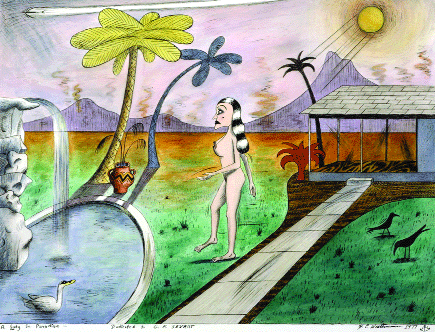H.C. Westermann exhibition of drawings demonstrates the limitless ways he honored his flower
In H.C. Westermann’s show of drawings, sculpture, and prints at Lennon Weinberg’s new Chelsea space, a post-mortem show explores images of his wife, Joanna, in many incarnations—as film star, goddess, seductress, slut and object of desire, as she inhabits one film noir landscape after another.
Westermann’s drawing style is direct and personal. His cartoon line tells the story in ways that others such as George Herriman, Saul Steinberg, Philip Guston, Peter Saul and other post-World War II American artists embraced. Westermann was born in 1922, he fought on the U.S.S. Enterprise in the war and then went to school in Chicago where his art career began with images of death ships drawn from his memory of enemy attacks that haunted him.
He was on the edge of pop art and the image-based Chicago school of the ‘70s. Although Westermann never gained the exposure won by New York-based pop artists, his influence is certainly felt in the “drawing explosion” currently underway in the New York gallery scene. His images are potent, personal and authentic, with a story and vision all his own.
Westermann died in 1981.
Joanna, “his little flower,” who appears in many guises throughout this exhibition, comes to us both naked and clothed, hair flowing and shiny, with an up-do with pearls or even bald with high heels. She is always his vision of the desire he left behind on shore. Joanna is introduced to many worlds—a city street, an abandoned wharf, a tropical paradise or a desert oasis, each rendered with real-life detail—without losing her aura as a symbol of perfect love. A tuxedo-wearing, slick, black-haired dandy of a man—a glamorous idealization of the artist himself—often accompanies her, trying to catch her eye and seduce her with every glance. They wander together through his worlds assuming different roles, whether in bed using the mountain range of covers, or seeking a loving embrace aside a bleak factory wall. Pigs, crows and dogs gaze at her as she journeys through technicolor tropical sunsets and desert paradises.
His drawing style is borderline naïve, but lends the scenes he captures a potent emotive visual necessity. His harsh liner style captures both beauty and life’s ironic side without falling into illustrative gimmicks. These images are the real thing, as true today as the day they were done. I hope younger artists really focus on this show because it discusses issues that are being “discovered” today and demonstrates how a personal style and vision need not be trite or sophomoric even when conceived in opposition to academic notions of draftsmanship.
Every line and color Westermann uses is necessary and enhances the narrative. Sex is always felt in these drawings without being particularly explicit, except in “See Tulsa First” (Tulsa spelt backwards is “a slut.”) But it is the sexual mores of the World War II generation that are transgressed in a vision formed before the sexual revolution and that’s the transgression honored here.
It’s Westermann’s strong male desire that I respond to, a feeling that evokes the sense we are witnessing something very private and intimate—something only to be seen by the recipient of a letter. In fact along with three wooden sculptures, several letters of Westermann’s are featured here as well.
Westermann is a true American hero.
gaycitynews.com


































